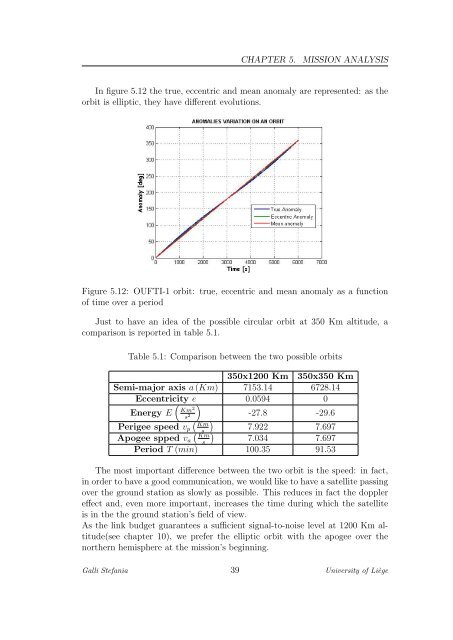Mission Design for the CubeSat OUFTI-1
Mission Design for the CubeSat OUFTI-1 Mission Design for the CubeSat OUFTI-1
CHAPTER 5Figure 5.11: OUFTI-1: orbit’s tridimentional view. Optimum case: the subsatellitepoint at apogee is at the same latitude as Liège.Given a perigee of 350 Km and an apogee of 1200 Km altitude, we calculatedall the above mentioned parameters:• semi-major axis: a = 7153.14Km• eccentricity: e = 0.0594• angular momentum: h = 5.33 · 10 4 Km2s• orbit parameter: p = 7127.7Km• energy: E = −27.8 Km2s 2• period: T = 6020.8s = 100.35min• perigee speed: v p = 7.922 Kms• apogee speed: v a = 7.034 Kms• mean motion: n = 14.35 revdayGalli Stefania 38 University of Liège
CHAPTER 5.MISSION ANALYSISIn figure 5.12 the true, eccentric and mean anomaly are represented: as theorbit is elliptic, they have different evolutions.Figure 5.12: OUFTI-1 orbit: true, eccentric and mean anomaly as a functionof time over a periodJust to have an idea of the possible circular orbit at 350 Km altitude, acomparison is reported in table 5.1.Table 5.1: Comparison between the two possible orbits350x1200 Km 350x350 KmSemi-major axis a (Km) 7153.14 6728.14Eccentricity e 0.0594 0Energy E(Km 2s 2 ))-27.8 -29.6(Perigee speed v Kmp(7.922 7.697sApogee spped v Km)a 7.034 7.697sPeriod T (min) 100.35 91.53The most important difference between the two orbit is the speed: in fact,in order to have a good communication, we would like to have a satellite passingover the ground station as slowly as possible. This reduces in fact the dopplereffect and, even more important, increases the time during which the satelliteis in the the ground station’s field of view.As the link budget guarantees a sufficient signal-to-noise level at 1200 Km altitude(seechapter 10), we prefer the elliptic orbit with the apogee over thenorthern hemisphere at the mission’s beginning.Galli Stefania 39 University of Liège
- Page 3: Space is probably the main symbol o
- Page 7 and 8: CONTENTS1 Introduction 132 The LEOD
- Page 9 and 10: LIST OF FIGURES4.1 A typical 1-unit
- Page 11: LIST OF TABLES5.1 Comparison betwee
- Page 15 and 16: CHAPTER2THE LEODIUM PROJECTThe LEOD
- Page 17: CHAPTER3THE FLIGHT OPPORTUNITYThe E
- Page 20 and 21: CHAPTER 44.1 The CubeSat conceptDur
- Page 22 and 23: CHAPTER 4have to be smooth and thei
- Page 25 and 26: CHAPTER5MISSION ANALYSISThe mission
- Page 27 and 28: CHAPTER 5.MISSION ANALYSIS5.1.1 Typ
- Page 29 and 30: CHAPTER 5.MISSION ANALYSISIt can be
- Page 31 and 32: CHAPTER 5.MISSION ANALYSISFigure 5.
- Page 33 and 34: CHAPTER 5.MISSION ANALYSIS5.2 The o
- Page 35 and 36: CHAPTER 5.MISSION ANALYSIS• the s
- Page 37: CHAPTER 5.MISSION ANALYSISt − t 0
- Page 41 and 42: CHAPTER 5.MISSION ANALYSIS• if m
- Page 43 and 44: CHAPTER 5.MISSION ANALYSIS5.3.3 The
- Page 45 and 46: CHAPTER 5.MISSION ANALYSISwhere ϑ
- Page 47 and 48: CHAPTER 5.MISSION ANALYSISFigure 5.
- Page 49 and 50: CHAPTER 5.MISSION ANALYSISA four ye
- Page 51 and 52: CHAPTER 5.MISSION ANALYSISFigure 5.
- Page 53 and 54: CHAPTER 5.MISSION ANALYSISFigure 5.
- Page 55: CHAPTER 5.MISSION ANALYSISFigure 5.
- Page 58 and 59: CHAPTER 66.1 Pumpkin structureThe s
- Page 60 and 61: CHAPTER 6Figure 6.2: ISIS structure
- Page 62 and 63: CHAPTER 6Figure 6.3: P-POD: deploym
- Page 64 and 65: CHAPTER 77.1 Inertia propertiesBefo
- Page 66 and 67: CHAPTER 7I x = I x,cube + I x,M + I
- Page 68 and 69: CHAPTER 7This rough estimation is e
- Page 70 and 71: CHAPTER 7Otherwise, an orbit simula
- Page 72 and 73: CHAPTER 7only slow down the rotatio
- Page 74 and 75: CHAPTER 8order to prevent any failu
- Page 76 and 77: CHAPTER 8We have now the vector ˆN
- Page 78 and 79: CHAPTER 8Here we add an important h
- Page 80 and 81: CHAPTER 8Figure 8.5: Total power pr
- Page 82 and 83: CHAPTER 8Figure 8.8: Total power an
- Page 84 and 85: CHAPTER 88.4 Battery and operating
- Page 86 and 87: CHAPTER 99.1 Passive thermal-contro
CHAPTER 5.MISSION ANALYSISIn figure 5.12 <strong>the</strong> true, eccentric and mean anomaly are represented: as <strong>the</strong>orbit is elliptic, <strong>the</strong>y have different evolutions.Figure 5.12: <strong>OUFTI</strong>-1 orbit: true, eccentric and mean anomaly as a functionof time over a periodJust to have an idea of <strong>the</strong> possible circular orbit at 350 Km altitude, acomparison is reported in table 5.1.Table 5.1: Comparison between <strong>the</strong> two possible orbits350x1200 Km 350x350 KmSemi-major axis a (Km) 7153.14 6728.14Eccentricity e 0.0594 0Energy E(Km 2s 2 ))-27.8 -29.6(Perigee speed v Kmp(7.922 7.697sApogee spped v Km)a 7.034 7.697sPeriod T (min) 100.35 91.53The most important difference between <strong>the</strong> two orbit is <strong>the</strong> speed: in fact,in order to have a good communication, we would like to have a satellite passingover <strong>the</strong> ground station as slowly as possible. This reduces in fact <strong>the</strong> dopplereffect and, even more important, increases <strong>the</strong> time during which <strong>the</strong> satelliteis in <strong>the</strong> <strong>the</strong> ground station’s field of view.As <strong>the</strong> link budget guarantees a sufficient signal-to-noise level at 1200 Km altitude(seechapter 10), we prefer <strong>the</strong> elliptic orbit with <strong>the</strong> apogee over <strong>the</strong>nor<strong>the</strong>rn hemisphere at <strong>the</strong> mission’s beginning.Galli Stefania 39 University of Liège



